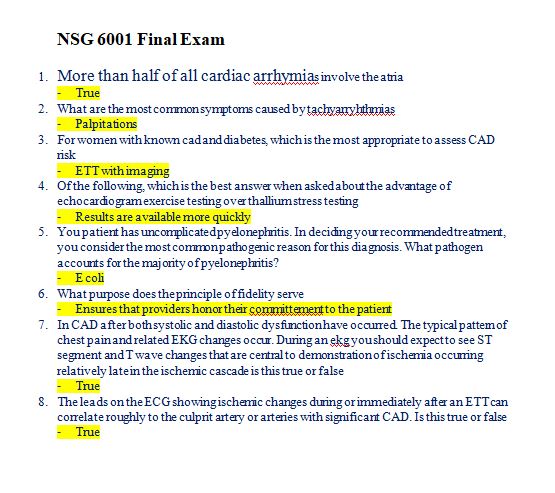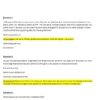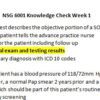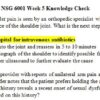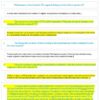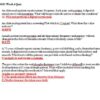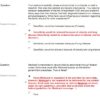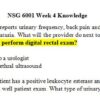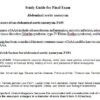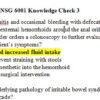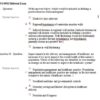Description
NSG 6001 Final Exam South University (Two Sets)
- More than half of all cardiac arrhymias involve the atria
- What are the most common symptoms caused by tachyarryhthmias
- For women with known cad and diabetes, which is the most appropriate to assess CAD risk
- Of the following, which is the best answer when asked about the advantage of echocardiogram exercise testing over thallium stress testing
- You patient has uncomplicated pyelonephritis. In deciding your recommended treatment, you consider the most common pathogenic reason for this diagnosis. What pathogen accounts for the majority of pyelonephritis?
- What purpose does the principle of fidelity serve
- In CAD after both systolic and diastolic dysfunction have occurred. The typical pattern of chest pain and related EKG changes occur. During an ekg you should expect to see ST segment and T wave changes that are central to demonstration of ischemia occurring relatively late in the ischemic cascade is this true or false
- The leads on the ECG showing ischemic changes during or immediately after an ETT can correlate roughly to the culprit artery or arteries with significant CAD. Is this true or false
- Skin cancer is the most common malignant neoplasms in males in the us . What is the second leading cause of cancer deaths in men greater than 50 years of age
- What ech changes can reduce the specificity of the ETT
- You have confirmed that your patient does indeed have an abdominal aortic aneurysm. In teaching your patient about symptoms to report immediately to the vascular surgeon you instruct the patient to report which of the following
- Which is one of the common causes of a saccular abdominal aneurysm
- The diagnostic accuracy of stress testing is decreased among women compared to men for what reasons
- Population disease management is a term …..to describe
- You receive a report back on the suspected abdominal aortic aneurysm for your patient. It confirms your suspicion of AAA. The report describes the aneurysm as a symmetric weakness of the entire circumference of the aorta. You know that this form of aneurysm is referred to as what kind of aneurysm
- You practice partner just ordered an exercise echocardiograph 2DE for a patient with suspected cardiovascular risk. This patient has known resting wall motion abnormalities. Why would this not be the best test to assess this patient’s cardiac risk
- Your 60-year-old male patient arrives for his appointment. He complains of general malaise and fever over the past several days with low back pain. He also states that he is getting up at night more often to urinate and never feels his bladder is completely empty. What differential diagnosis should you consider in this patient
- We all know that collaboration in integral to becoming a successful nurse practitioner. Among collaboration, however, only one can be considered the most important. While each example below is important, which is the most important collaboration. The one that occurs:
- The sensitivity of a routine ETT is effort dependent. What physiological changes occur during effort in the routine ETT?
- A 47-year-old female with general complaints of fatigue and shortness of breath show up in your clinic as a referral from another nurse practitioner. Several blood tests and chest xrays have been completed without any diagnosis or outstanding abnormalities. You decide to order an ETT despite the fact that the recent ecg does not show any abnormalities. From the answers below which would be the best answer to support your decision
- Your patient underwent an exercise stress test for CAD. There is significant elevation of the ST segment. What do you need to know about these changes to manage your patients care?
- When there is a consequential loss of structural integrity of the abdominal aorta, the resulting issue is what condition
- You see a 60yr old AA male in your clinic with a recent diagnosis of htn. He asks you what he should restrict in his diet. And is particularly interested in limiting his sodium intake. What amount of sodium intake would you recommend on a daily basis for this patient?
- Why would inability to exercise reduce the specificity of the routine ETT
- By standard criteria, how is a positive stress test …..
- What are the two types of bradycardia recognized by the American heart association
- You see a 75-year-old female in your clinic complaining of urinary incontinence. She is otherwise health based upon her last visit. She states that her mother told her this would happen someday because it happens to every woman at some age. What would you tell this patient?
- What 3 conditions definitely alter the results of echocardiography in determining CAD
- Specifically, when is an ETT considered to be negative
- What do you know regarding ischemia that is confined to only the posterior and or lateral segments of the left ventricle?
- All patient even if asymptomatic require risk stratification according to the Framingham risk score. At present ACC/AHA guidelines however do not normally support stress tests for asymptomatic patients without additional justification. What could be used to justify ETT in an asymptomatic patient
- BPH is not a risk factor for prostate cancer. Is this true to false
- Spread of genital herpes only occurs during the time period with active lesions. Is the true or false
- AAA are often asymptomatic, what percent of AAA are discovered in asymptomatic patient nsg 6001 final exam
- Improvement in the delivery and management of the healthcare are necessary if we are to improve the overall health of this nation’s population. Which of the following are identified in your readings as strategic in the movement to improve healthcare system?
- Two main types of heart failure
- The majority of all strokes are non-ischemic. Is this statement true or false?
- When a murmur is first heard. It is important to determine if it is due to a pathological condition or benign. For an experienced practitioner, it is always easy to determine the cause of a murmur merely by listening to the sound. Is this true or false
- Maintenance of an isometric ST segment during exercise is the response of
- The goal of self-management is to specifically do what
- Your 56-year-old patient presents with bradycardia with a rate of 55 and first degree av block. The patient is hemodynamically stable and is not experiencing any syncope or chest pain. Hx includes: MI, home meds include BB, ASA, Lab work is non-significant for electrolyte imbalances. You decide to treat this patient for the arrhythmia to prevent future destabilizations. Which might be the appropriate first measure to consider
- Your patient is morbidly obese and cannot sit on a bicycle or walk a treadmill. She also has marked and severe emphysema. You need to make an assessment of the risk of significant CAD and your patients family says that their relative had their diagnosis base don an ultrasound echo. What facts would influence your decisions regarding the family request for echo assmnt
- Your are in a clinic with your mentor observing the echocardiogram exercise teset of a 45 year old male that had been experiencing slight chest pressure almost daily during exercise. While observing your patient, your mentor points out that the left ventricle wall is thinning and there is some hyperkinesia nsg 6001 final exam
- Your patient is newly diagnosed with persistent atria fibrillation. You consider electro cardioversion. Before undergoing this procedure you should order the following examination to assess thrombus risk
- Tachyarrhythmias cause a drop in commonly blood pressure, cardiac output syncope sob, cp. What phenomenon most often occurs during these arrhythmias to cause these s/s
- At what age is afib most common
- Automaticity is a property common to all cardiac cells
- Your pt has a maximum age predicted HR of 180. During the exercise eh reaches a heart rate of 140 and then states he can no longer exercise. You see evidence of ischemic changes on the ecg. This would be predictive of what condition
- You tell a patient he has a murmur. He says he has been told this before, but wonders what causes the unique sounds of a murmur. Which of the following would be your best option
- What is the treatment of choice for uncomplicated community acquired cystitis
- Any pt presenting with symptomatic bradycardia should be referred to a cardiologist
- Encouragement of pts to take effective action in their healthcare refers to the concept of
- You are considering adding an adjunctive form of testing to detect wall motion abnormalities during the ETT. You select echocardiography as the added testing. You-choose this test because you known that echocardiography does what when added to a standard ETT
- Medicaid is mandated to be provided by each state through federal codes. Each state must offer Medicaid exactly as the fed gvmt prescribes
- What sexually transmitted disease is most widespread in the USA today
- Your preceptor decides to add doppler flow atudies to the echocardiogram exercise test for a patient with a recent history of a holistic murmur best auscultated at the left sternal border. The patient has no history of cardiac surgeries. He asks you what might be the main advantages of adding doppler flow for this particular patient. You know from your readings that there are several reasons to add doppler flow for this particular patient. Your best response for this specific case, however would be that doppler flow studies would be of what additive value during the echocardiogram study
- Sexual partners of a patient with diagnosed STI should always be …… Is this true or false nsg 6001 final exam
- Your patient presents with tachycardia. The QRS is measured at .10 seconds. Which of the following tachycardias would be an appropriate conclusion based on this information alone
- A 65 year old white male arrives in your clinic with general complaints of slight abdominal discomfort. He has a known history of smoking two packs per day for 40 years and hypertension. He also has copd and has been …..numerous times with oral steroids. You consider optimal diagnoses. Of the ones listed below which should be ….as a potential top suspect in our choice of diagnosis
- What are the most common mechanisms to produce cardiac arrhythmias nsg 6001 final exam
- Patient urinates then has incontinence right after what type of incontinence is this
- How long should you take TMP-SMZ for uncomplicated UTI
- If someone presents with atrial arrythmia and is stable hemodynamically what intervention will you plan
- What signifies impending AAA rupture
- Who is at the highest risk with AAA
- Most common cause of AAA rupture
- The two types of AAA are fusiform and saccular.. if you have a bleb on one side what type is this
- Gives definition and says what does this represent think the answer is veracity, the other didn’t make sense. Mentions about being truthful and honest with patients
- UTI in 35 year old denies homosexual activities what else will you ask .. you know this is uncommon is adults younger than 35.
- Why is there more prevalence of chlamydia nsg 6001 final exam
- Who is eligible under Medicaid?
- There is abnormal left ventricle EF without ischemia what does this mean?
- The next questions asks the same questions but says theres evidence of ischemia so I put it indicates CAD
- Women and CT imaging is …..because of
- #1 leading cause of death in women
- If AAA is 4cm in healthy adult what intervention would you do
- What is relative bradycardi
- What is the definition of CHF
- Question about pt wanting to start exercise and is obese what test will the provider order
- Drug for ETT
- 2 common types of ETT
- Most common cause of systolic HF
- What indicates a positive Stress test
- You are in the clinic with your mentor observing the echo exercise test of a 45 year old who has been experiencing slight chest pressure almost daily during exercise. While observing your patient your mentor points out that the left ventricle wall is thinning and there is some hyperkinesias of the ventricular wall. From your time in the clinic you know that this test will be what type of result
- Medicare covers inpatient hospital services under which part of the medicare insurance
- Of the answers below which would be ……in defining a positive Exercise echocardiogram
- A 35 year old female arrives at your clinic, she has had diabetes and peripheral artery disease for the past 5 years. You decide to obtain an ETT. The insurance company argues that this is appropriate. You justify the ETT because you are planning secondary strategies to prevent future heart disease. Where could one find the supporting data for these guidelines
- Medicare hospital insurance is …..through what system
- Your patient underwent an exercise stress test for CAD. There is significant elevation of the ST segment. What do you need to know about these changes to manage your patients care
- Population disease management is a term …..to describe
- You are counseling a patient diagnosed with stress induced ischemia. You base your discussion on your knowledge that stress induced ischemia is …..
- AAA are often asymptomatic, what percent of AAA are …..in asymptomatic patient
- Improvement in the delivery and management of the healthcare are necessary if we are to improve the overall health of this nations population. Which of the following are …..in your readings as strategic in the movement to improve healthcare system
- Your patient is morbidly obese and cannot sit on a bicycle or walk a treadmill. She also has marked and severe emphysems. You need to make an assessment of the risk of significant CAD and your patients family says that their relative had their diagnosis base don an ultrasound echo. What facts would influence your decisions regarding the family request for echo assmnt
- Question about where the J point?
